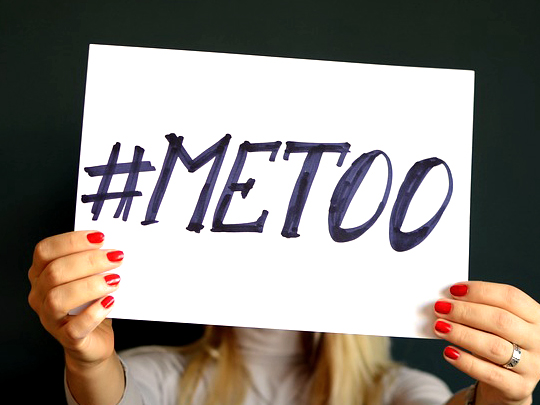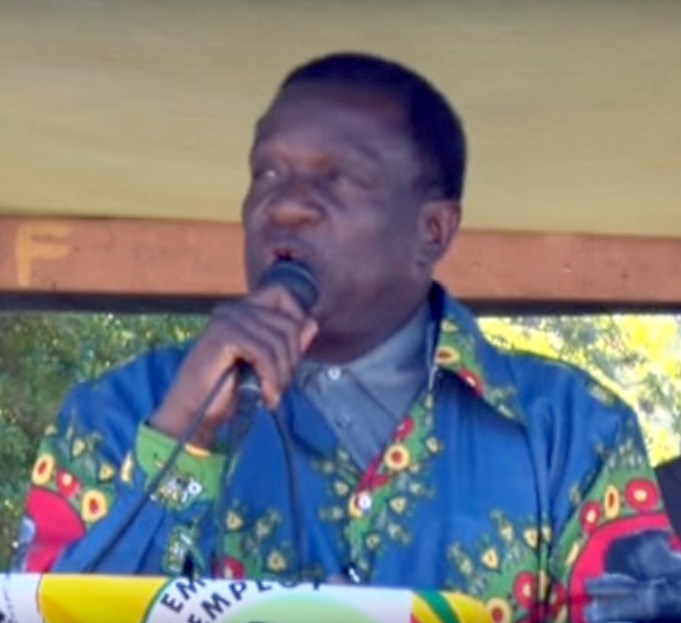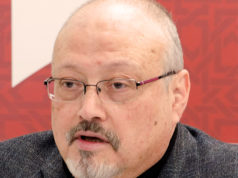Wikimedia Commons / CC-BY-SA-3.0 / GFDL
1 – Donald Trump Sworn-in as the 45th U.S. President
The inauguration of Donald Trump as the 45th President of the United States marked the beginning of his Presidency on 20 January 2017. The ceremony was held on the West Front of the United States Capitol Building in Washington, D.C.
White House press secretary, Sean Spicer, caused controversy when he stated the crowd was the largest ever to witness an inauguration, more than the 1.8 million there to witness Barack Obama’s first inauguration in 2009.
Experts estimate the true size of the crowd was somewhere between 300,000 to 600,000 people at Trump’s inauguration.
The presidential oath was administered by Chief Justice of the United States John Roberts. Trump was sworn in with his left hand on a pair of Bibles, his personal copy and the Lincoln Bible.
Nielsen ratings showed TV viewership of the inauguration in the US was 30.6 million, which was more than Obama’s second inauguration audience of 20.6 million, but less than Obama’s first inauguration audience of 38 million.
However, Trump’s inauguration did become the most-streamed Twitter video in the site’s decade-long history with over 6.8 million views.
After taking office, Trump repealed environmental protections, ended the Clean Power Plan, withdrew from the Paris Agreement on climate change mitigation, and urged for subsidies to increase fossil fuel production.
Trump failed in his attempt to repeal the Affordable Care Act. He enacted a partial repeal of the Dodd-Frank Act that had imposed stricter constraints on banks following the 2008 financial crisis and withdrew from the Trans-Pacific Partnership.
The Tax Cuts and Jobs Act of 2017 lowered corporate and estate taxes permanently, among policies projected to add $4 trillion to the national debt by 2029.
The introduction of tariffs on steel and aluminum imports and other goods triggered retaliatory tariffs from Canada, Mexico, and the EU, and a trade war with China.
Trump’s administration has drawn the U.S. closer to Saudi Arabia and Israel, agreeing to a $110 billion arms deal with Saudi Arabia, and recognizing Jerusalem as the capital of Israel, while also withdrawing the U.S from the Iran Deal.
Following failed attempts to get funding for a Mexican border wall, the longest government shutdown in American history resulted. He also issued an executive order denying citizens from some Muslim-majority countries entry into the U.S.
In August 2019, Trump broached the idea of buying Greenland from Denmark. When the suggestion was laughed off by the Danish Prime Minister, Trump canceled a state visit scheduled for the following month.
2 – Las Vegas Shooting

On the night of 1 October 2017, a lone gunman opened fire on a crowd of concert-goers at the Route 91 Harvest music festival on the Las Vegas Strip in Nevada. It was the final day of the festival, with over 22,000 people in attendance.
In total, the gunman killed 58 people and wounded over 420 others, while the ensuing panic brought the injury total to 851 people.
The shooter, Stephen Paddock, a 64-year-old man from Mesquite, Nevada, fired more than 1,100 rounds of ammunition from his 32nd-floor suite in the Mandalay Bay Hotel.
Between September 25 and October 1, Paddock stockpiled an arsenal of weapons and ammunition, including 14 AR-15 rifles he had equipped with bump stocks and 100-round magazines, 8 AR-10 rifles, a bolt-action rifle, and a revolver.
Prior to the shooting, Paddock used a hammer to break two windows in his suites, before proceeding to target the festival-goers approximately 490 yards (450 m) away.
The shooting started shortly after 10 pm for a period of around 10 minutes. When police managed to get into Paddock’s room, he was found dead from a self-inflicted gunshot wound. His motive remains undetermined.
The incident became the deadliest mass shooting committed by an individual in the history of the United States.
Paddock’s use of bump stocks made the AR-15’s fire shots in rapid succession, at a rate of fire similar to automatic weapons.
In December 2018, bump stocks were banned by the U.S. Justice Department, with the regulation in effect as of March 2019.
3 – #MeToo Movement

The #MeToo movement is a movement against sexual harassment and sexual assault, which began to spread virally in October 2017.
The MeToo hashtag on social media came to demonstrate the widespread prevalence of sexual assault/harassment, especially in the workplace.
American actress Alyssa Milano encouraged victims of sexual harassment to tweet about it to give people an idea of the scale of the problem.
Tens of thousands of people have used the hashtag to share their stories, with millions more using the hashtag on Facebook and Twitter to show their support.
A number of high-profile celebrities, such as Rose McGowan, Ashley Judd, and Uma Thurman, spoke out about their experiences of sexual harassment and assault.

In October 2017, The New York Times and The New Yorker first reported that dozens of women were making accusations of abuse against American film producer Harvey Weinstein.
Since the first allegations against Weinstein, over eighty women in the film industry have accused him of sexual assault, sexual abuse, and even rape over a 30-year period.
Male actors, such as Terry Crews, and James Van Der Beek, have also shared their own experiences of harassment and abuse in the film industry.
The so-called “Weinstein effect” was seen as a tipping point against sexual harassment, with many famous or powerful people subsequently accused of sexual misconduct.
Among the high profile men who were either fired or shunned in the fallout was actor Kevin Spacey, filmmaker James Toback, television hosts Charlie Rose and Matt Lauer, and CBS chairman Leslie Moonves.
The Times and the New Yorker were subsequently awarded the 2018 Pulitzer Prize for Public Service for their coverage of the Weinstein allegations.
4 – London & Manchester Attacks

Westminster Attack
On 22 March 2017, a terrorist attack took place outside the Palace of Westminster in London, the seat of the British Parliament.
The 52-year-old attacker, Khalid Masood, drove a car into pedestrians on the pavement along the south side of Westminster Bridge and Bridge Street, injuring over 50 people, 4 of them fatally.
Masood then crashed the car into the perimeter fence of the Palace grounds and ran into New Palace Yard, where he fatally stabbed an unarmed police officer. An armed police officer then shot Masood, who died at the scene.
The entire attack lasted 82 seconds, from start to finish. Police later found no link with a terrorist organization and believe Masood acted alone.
London Bridge Attack
On 3 June 2017, three terrorists deliberately drove a van into pedestrians on London Bridge before crashing on the south bank of the River Thames in London, England.
The three men then ran to the nearby Borough Market area, where they began stabbing people in and around restaurants and pubs.
The attackers, inspired by ISIS, were shot dead by Metropolitan Police officers and were found to be wearing fake explosive vests.
In total, 8 people were killed and a further 48 were injured, including four unarmed police officers who had attempted to stop the assailants.
The attack happened almost three months after a similar vehicle-ramming and stabbing attack at Westminster Bridge in London.

Manchester Arena Bombing
The Manchester Arena bombing was a suicide bombing attack in Manchester, England on 22 May 2017.
A radical Islamist detonated an improvised explosive device, packed with shrapnel, in the foyer of the Manchester Arena as people were leaving a concert by the American singer Ariana Grande.
Twenty-three people died, including the attacker, and a further 139 were wounded, with more than half of them children, while hundreds more suffered psychological trauma.
The bomber was Salman Ramadan Abedi, a 22-year-old local man, who police determined had largely acted alone, but others had been aware of his plans.
The incident was the deadliest terrorist attack and the first suicide bombing in the United Kingdom since the 7 July 2005 London bombings.
On 4 June, Ariana Grande hosted a benefit concert, entitled “One Love Manchester” at Old Trafford Cricket Ground in Manchester, broadcast live on tv, radio and social media.
Grande performed with several other high-profile artists. The concert and associated Red Cross fund had raised £17 million for victims of the attack by August.
5 – Grenfell Tower Fire

On 14 June 2017, a fire broke out in the 24-story Grenfell Tower block of flats in North Kensington, West London just before 1 am. It ultimately caused 72 deaths, including two victims who later died in the hospital.
Over 70 people were injured, while 223 people escaped to safety. It was the worst UK residential fire since World War II.
The fire was started by a malfunctioning fridge-freezer on the fourth floor, before spreading rapidly up the building’s exterior.
This rapid spread has been attributed to the material used in the building’s cladding. The fire burned for about 60 hours before eventually being extinguished.
Over 250 London Fire Brigade firefighters and more than 100 London Ambulance Service crews assisted the rescue effort, among many other responders.
The Grenfell Tower Inquiry began on 14 September 2017 to investigate the causes of the fire and other related issues.
In the aftermath of the fire, the Kensington and Chelsea London Borough Council’s leader and chief executive resigned, and the council took direct control of council housing from the Kensington and Chelsea Tenant Management Organisation.
In May 2018, a report on building regulations, and fire safety was published finding other tower blocks had similar cladding. Efforts to replace the cladding on these buildings are ongoing.
6 – Barcelona Attack

On the afternoon of 17 August 2017, 22-year-old Younes Abouyaaqoub drove a van into pedestrians on La Rambla in Barcelona, Spain, killing 13 people and injuring at least 130 others, one of whom died 10 days later.
Abouyaaqoub fled the attack on foot, before killing the driver of a car in order to steal the victim’s car and make his escape.
Nine hours later, five men of the same terrorist cell drove into pedestrians in nearby Cambrils, killing one woman and injuring six others. All five were shot and killed by police.
The night before the attack, an explosion destroyed a house in the Spanish town of Alcanar, killing two members of the terrorist cell, including the mastermind, a 40-year-old imam.
The house contained over 120 gas canisters, which the cell was believed to be attempting to make into a larger bomb, but accidentally detonated it instead.
The attacks were the deadliest in Spain since the March 2004 Madrid train bombings. The driver of the van in the Barcelona attack was killed by police 30 miles west of Barcelona on 21 August.
7 – Charlottesville Rally & Car Attack

The Unite the Right rally was a white supremacist rally in Charlottesville, Virginia, on 11/12 August 2017.
The rally occurred amidst the backdrop of the removal of Confederate monuments throughout the country in response to the Charleston church shooting in 2015.
Protesters were members of the far-right and included self-identified members of the alt-right, neo-Confederates, neo-fascists, white nationalists, neo-Nazis, Klansmen, and various right-wing militias.
The marchers chanted racist and antisemitic slogans, carried semi-automatic rifles, Nazi symbols such as the swastika, Confederate battle flags, and other provocative symbols.
The organizers’ stated goals included unifying the American white nationalist movement and opposing the removal of the statue of Robert E. Lee from Charlottesville’s Lee Park.
The event turned violent after protesters clashed with counter-protesters, leaving more than 30 injured. On 12 August, Virginia governor Terry McAuliffe declared a state of emergency, stating public safety could not be safeguarded without additional powers.
A white supremacist, James Alex Fields Jr., then deliberately rammed his car into a crowd of counter-protesters near the rally site, killing one person and injuring 19 others.
Fields fled the scene but he was arrested shortly after. He was tried and convicted of first-degree murder, malicious wounding, and other crimes. In 2019, Fields pleaded guilty to 29 federal crimes in exchange for prosecutors’ agreement not to seek the death penalty.
When questioned about the rally, U.S. President Donald Trump, controversially, did not denounce the marchers, instead, condemning “hatred, bigotry, and violence on many sides”. He also referred to “very fine people on both sides”.
Events around the rally triggered a backlash against white supremacist groups in the U.S. A number of participant groups had events canceled by universities and their financial and social media accounts closed.
Unite the Right held an anniversary rally in August 2018, in Washington D.C. However, the rally saw only 20–30 protesters turnout amidst thousands of counter-protestors.
8 – North Korea Ballistic Missile Tests

On 4 April 2017, North Korea launched a Hwasong-12 ballistic missile which reached the Sea of Japan. The test came after a day of celebration for North Korea’s Eternal President Kim Il-sung.
In total, 17 missile tests were conducted throughout 2017. These tests are notable due to the several instances of missiles passing over Japan, provoking a response from the Japanese government.
On 4 July, North Korea tested an intercontinental ballistic missile (ICBM). The missile flew for approximately 40 minutes, falling 930 km (580 mi) away from the launch site. The test and range of the ICBM prompted an Emergency Debate of the UN Security Council.
In September, North Korea fired an intermediate-range ballistic missile from Pyongyang International Airport. It traveled 3,700 km (2,300 mi), reaching a maximum height of 770 km (480 mi), the furthest distance any North Korean IRBM missile has ever reached.
These missile launches, along with North Korea conducting a nuclear test in early September, led to heated rhetoric exchanged with U.S. President Trump.
The escalating rhetoric stoked fears of a possible war with the U.S., while North Korea also threatened Australia twice with nuclear strikes in 2017, accusing them of siding with the U.S.
9 – Robert Mugabe Deposed in Zimbabwe

On the evening of 14 November 2017, members of the Zimbabwe Defence Forces (ZDF) gathered around Harare, the capital of Zimbabwe, seizing control of the Zimbabwe Broadcasting Corporation and key areas of the city.
The following day, the ZDF issued a statement saying it was not a coup d’état and President Robert Mugabe was safe.
However, they also stated the situation would only return to normal after the ZDF had dealt with those responsible for the socio-economic problems in the country.
The uprising took place amid tensions in the ruling ZANU–PF party between former First Vice-President, and ZDF-backed, Emmerson Mnangagwa and First Lady Grace Mugabe over who would succeed the 93-year-old President Mugabe.
A week after Mnangagwa was fired and forced to flee the country, and a day before the troops moved into Harare, ZDF chief Constantino Chiwenga issued a statement that purges of senior ZANU–PF officials like Mnangagwa had to stop.
On 19 November, ZANU-PF removed Mugabe as party leader, replacing him with Mnangagwa, and issued a deadline of 20 November for Mugabe to resign the presidency or face impeachment.
Mugabe did not resign, so on 21 November, a joint session of Parliament met for his impeachment. However, Mugabe then sent a letter to Zimbabwe’s Parliament resigning the presidency.
Mnangagwa was sworn in as President of Zimbabwe on 24 November 2017.









